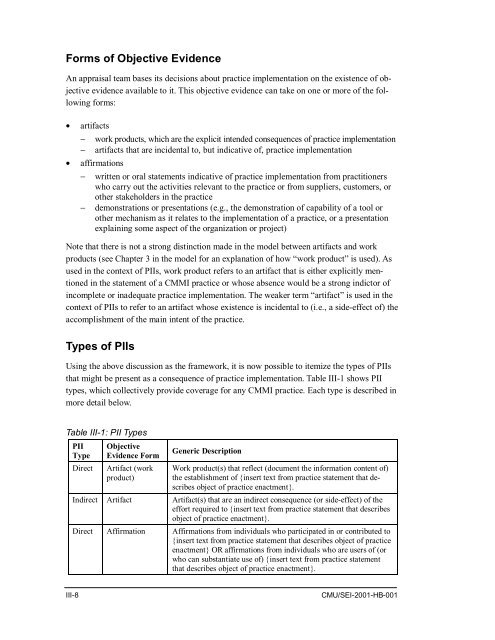Standard CMMI Appraisal Method for Process Improvement (SCAMPI)
Standard CMMI Appraisal Method for Process Improvement (SCAMPI)
Standard CMMI Appraisal Method for Process Improvement (SCAMPI)
Create successful ePaper yourself
Turn your PDF publications into a flip-book with our unique Google optimized e-Paper software.
Forms of Objective Evidence<br />
An appraisal team bases its decisions about practice implementation on the existence of objective<br />
evidence available to it. This objective evidence can take on one or more of the following<br />
<strong>for</strong>ms:<br />
• artifacts<br />
− work products, which are the explicit intended consequences of practice implementation<br />
− artifacts that are incidental to, but indicative of, practice implementation<br />
• affirmations<br />
− written or oral statements indicative of practice implementation from practitioners<br />
who carry out the activities relevant to the practice or from suppliers, customers, or<br />
other stakeholders in the practice<br />
− demonstrations or presentations (e.g., the demonstration of capability of a tool or<br />
other mechanism as it relates to the implementation of a practice, or a presentation<br />
explaining some aspect of the organization or project)<br />
Note that there is not a strong distinction made in the model between artifacts and work<br />
products (see Chapter 3 in the model <strong>for</strong> an explanation of how “work product” is used). As<br />
used in the context of PIIs, work product refers to an artifact that is either explicitly mentioned<br />
in the statement of a <strong>CMMI</strong> practice or whose absence would be a strong indictor of<br />
incomplete or inadequate practice implementation. The weaker term “artifact” is used in the<br />
context of PIIs to refer to an artifact whose existence is incidental to (i.e., a side-effect of) the<br />
accomplishment of the main intent of the practice.<br />
Types of PIIs<br />
Using the above discussion as the framework, it is now possible to itemize the types of PIIs<br />
that might be present as a consequence of practice implementation. Table III-1 shows PII<br />
types, which collectively provide coverage <strong>for</strong> any <strong>CMMI</strong> practice. Each type is described in<br />
more detail below.<br />
Table III-1: PII Types<br />
PII<br />
Type<br />
Direct<br />
Objective<br />
Evidence Form<br />
Artifact (work<br />
product)<br />
Generic Description<br />
Work product(s) that reflect (document the in<strong>for</strong>mation content of)<br />
the establishment of {insert text from practice statement that describes<br />
object of practice enactment}.<br />
Indirect Artifact Artifact(s) that are an indirect consequence (or side-effect) of the<br />
ef<strong>for</strong>t required to {insert text from practice statement that describes<br />
object of practice enactment}.<br />
Direct Affirmation Affirmations from individuals who participated in or contributed to<br />
{insert text from practice statement that describes object of practice<br />
enactment} OR affirmations from individuals who are users of (or<br />
who can substantiate use of) {insert text from practice statement<br />
that describes object of practice enactment}.<br />
III-8<br />
CMU/SEI-2001-HB-001
















